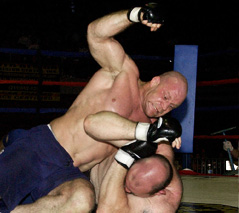ABOUT MIXED MARTIAL ARTS
WHAT IS IT?
Mixed martial arts (MMA) is a full contact combat sport which incorporates a variety of fighting techniques from a number of different martial arts. The techniques used in MMA competition generally fall into two categories: striking techniques, including kicks, knees, punches, and elbow strikes, and grappling techniques, such as clinch holds, sweeps, takedowns, ground control, and submissions.
Becase there is no universal sanctioning body for the mixed martial arts, the rules vary slightly between different promotions. Dangerous or excessively brutal techniques are universally banned. These invlude headbutts, biting, groin and throat strikes, eye-gouging, fish-hooking and small joint manipulations. Other attacks, such as elbow strikes and spinal submissions, are banned from some shows but legal in others.
Mixed martial artists cross-train in a variety of styles to counter their opponent's strengths and to remain effective in all the ranges of the fighting game. For example, a stand-up fighter will have little opportunity to use punching and kicking skills against a wrestler or a submission artist who is very effective at take downs. Because of this, boxers and kickboxers must cross-train in wrestling in order to prevent their opponents from taking them to the ground where they may not fight as effectively. The most dangerous fighters are highly skilled at all ranges and can fight equally well whether standing or on the ground.
DIFFERENT MARTIAL ARTS USED IN MMA:
Stand-up & Striking arts: Boxing, kickboxing, Muay Thai, and and different forms of full contact karate, tae kwon do, and kung-fu. These martial arts provide good footwork and striking techniques (kicks, knees, punches, elbows)
Arts which capitalize on the Clinch: Freestyle and Greco-Roman wrestling, Sambo, and judo. These arts provide skills used in the clinch, facilitating takedowns and throws. While not a grappling art per se, Muay Thai also places a heavy emphasis on the clinch, from which elbow and knee strikes are used.
Groundfighting arts: Brazilian Jiu-Jitsu, judo, and Sambo are all "submission" arts, utilizing a wide variety of chokes and joint manipulations to force an opponent to surrender. Traditional western wrestling is also very popular in MMA, giving fighters an advantage in position and ground control. When a fighter is able to secure and maintain a dominant position, devastating strikes can be delivered and the opponent can often be immobilized so that he is unable to answer with an attack of his own.
MIXED MARTIAL ARTS GLOSSARY
GROUND POSITIONS SEEN IN MMA:
Here we will review some basic positions typically observed in a mixed martial arts match. When fighting on the ground, a fighter must secure an advantageous position in order to launch an attack.
THE MOUNT POSITION
 When one fighter fully straddles a supine opponent's chest, he is said to be in the "mount" position, and his opponent is said to be "mounted." From this position, the top fighter is able to deliver unanswered punches and elbows. A number of submissions are also available to the top fighter from the mount. The mounted fighter generally has no offense from this position and his only real option is to escape or reverse the position.
When one fighter fully straddles a supine opponent's chest, he is said to be in the "mount" position, and his opponent is said to be "mounted." From this position, the top fighter is able to deliver unanswered punches and elbows. A number of submissions are also available to the top fighter from the mount. The mounted fighter generally has no offense from this position and his only real option is to escape or reverse the position.
THE GUARD POSITION
 The "guard" position occurs when one fighter, laying on his back, has the top fighter secured between his legs. By using his legs, the bottom man can effectively control the top man. When skillfully executed, the guard position is a dominant offensive position for the bottom man. A number of striking and submission holds can be employed from the guard position, and sweeps and reversals are also possible. The top fighter may choose to sit in the guard and avoid submission attempts while striking down at the bottom fighter, or he may attempt to "pass the guard" in order to attain side control and eventually a full mount.
The "guard" position occurs when one fighter, laying on his back, has the top fighter secured between his legs. By using his legs, the bottom man can effectively control the top man. When skillfully executed, the guard position is a dominant offensive position for the bottom man. A number of striking and submission holds can be employed from the guard position, and sweeps and reversals are also possible. The top fighter may choose to sit in the guard and avoid submission attempts while striking down at the bottom fighter, or he may attempt to "pass the guard" in order to attain side control and eventually a full mount.
THE HALF MOUNT POSITION
(AKA HALF GUARD)
 This position is halfway between the mount and the guard, when the top fighter has one leg trapped between the legs of the bottom man. It is still a dominant position for the top fighter, but the best option from this position is to finish "passing the guard" in order to attain side control or a full mount. The bottom man is better able to defend than when fully mounted, but still cannot launch an effective offense from this position. The bottom man's best option from the half mount is to escape, reverse, or recompose a full guard.
This position is halfway between the mount and the guard, when the top fighter has one leg trapped between the legs of the bottom man. It is still a dominant position for the top fighter, but the best option from this position is to finish "passing the guard" in order to attain side control or a full mount. The bottom man is better able to defend than when fully mounted, but still cannot launch an effective offense from this position. The bottom man's best option from the half mount is to escape, reverse, or recompose a full guard.
THE CROSS-SIDE POSITION
(AKA SIDE-CONTROL)
 When one fighter is lying atop another fighter, controling his upper body, he is said to be in "side-control" or the "cross-side" position. This is a dominant position for the top fighter who has a number of options including various strikes and submissions. As with the mount, the bottom man has little offense or defense from this position, and his best option is to either recompose the guard, reverse the position, or escape entirely.
When one fighter is lying atop another fighter, controling his upper body, he is said to be in "side-control" or the "cross-side" position. This is a dominant position for the top fighter who has a number of options including various strikes and submissions. As with the mount, the bottom man has little offense or defense from this position, and his best option is to either recompose the guard, reverse the position, or escape entirely.
MIXED MARTIAL ARTS GLOSSARY
SUBMISSION TECHNIQUES SEEN IN MMA:
Here we will review some of the basic submission techniques that are often seen in MMA.
REAR-NAKED CHOKE
(AKA MATA LEAO)
GUILLATINE CHOKE
TRIANGLE CHOKE
ARMLOCK
KIMURA
ANKLE LOCK
FOR MORE INFORMATION ABOUT THE MIXED MARTIAL ARTS, VISIT THE FOLLOWING LINKS:
- Wikipedia: Mixed Martial Arts
- Mixed Martial Arts on Yahoo Sports
- Mixed Martial Arts at ESPN.com
- Google Search: Mixed Martial Arts











